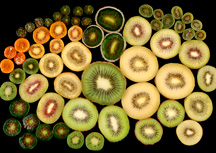I love the word germplasm! It sounds all organic and squelchy, like wet bits inside a plant cell. \But it's not an onomatopoeic word (if that is a word in itself). Wikipedia defines germplasm as meaning a collection of genetic resources for an organism. So for example, for plants, germplasm can be a stored seed collection or for trees, a nursery or botanical collection (like my favourite
Breadfruit Institute). In a world where humans are bent on taking over and turning every bit of usable land into cultivation, roads or cities, conserving germplasm resources becomes very critical.
 |
| Kiwifruit germplasm - Plant & Food Research New Zealand |
In an earlier post, I talked about the ancestry of wheat - quite a remarkable breeding effort by early human civilisations in weaving something quite harvestable and edible out of a collection of a couple of different grass species, in a series of crosses. How these early plant breeders, 10,000 years ago, mucked around with the less than "useful" weeds like Goat's grass
(Aegilops tauschii ) and einkorn wheat
(Triticum urartu) to form such a staple crop as wheat, we can only ponder now. Various groups are now using these ancestral parents to try to make new crosses to improve on modern wheats, such as the
National Institute of Agricultural Botany in the UK. But they could not do so if it weren't for the efforts of dedicated people over the past 80 or so years, collecting germplasm from wild populations and saving them in seed banks around the world.
Some of the most famous germplasm centres in the world are the
Svalbard Global Seed Vault in Norway,
CIMMYT in Mexico, and
ICRISAT in Syria. New Zealand has it's very own centre in the
Margot Forde Germplasm Centre - a collection or pastoral and arable species which form the basis of agricultural production in New Zealand. The collection superviser, Zane Webber, heads overseas twice a year on collection trips into places like Sicily and Russia, hunting out new sources of ryegrasses and clover which may be of benefit to New Zealand plant breeders.
I was recently interviewed by Richard Loe on Radio Live about the changes the Ministry for Primary Industries has madeto enable New Zealand breeders better access to seed within this collection.
htt\/www.radiolivesport.co.nz/Audio/Katheryn-Hurr---MPI/tabid/454/articleID/14923/Default.aspx and here
http://www.radionz.co.nz/news/rural/214563/rules-change-for-imported-seeds

It's not impossible for non-scientists to be involved in germplasm conservation.
Kay Baxter of the Koanga Institure in Northland is a great example of a woman with a mission to save New Zealands heritage vegetable and fruit tree varieties. And Mark Christensen of the
Central Tree Crops Research Trust (part of the Tree Crops Association) is also coordinating some large projects around apples, tomatoes and beans.
Plenty of inspiration there.


